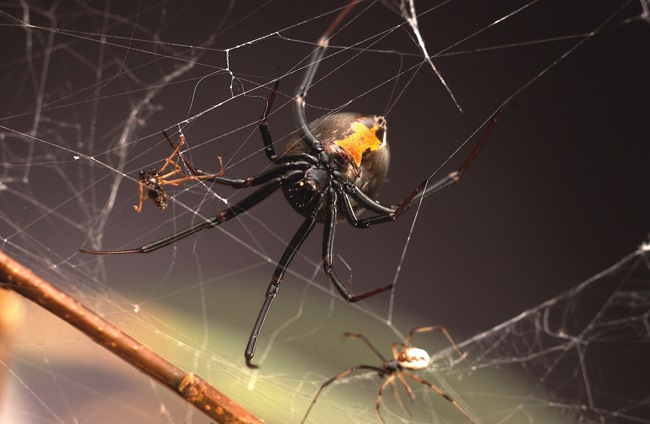Q&A with Stefan Schulz
For some spider species, love definitely is in the air. These arthropods emit sex pheromones, which are volatile compounds, to communicate with prospective mates, initiate courtship and accept partners. Stefan Schulz at the Technische Universitӓt Braunschweig in Germany is an expert in spider pheromones. He spoke with science writer Rajendrani Mukhopadhyay about what is known about the pheromones that spiders emit for sex and other purposes. The interview has been edited for length and clarity.
 Why is it important to study spider pheromones?
Why is it important to study spider pheromones?
A: One important factor is to understand spider biology, because spiders are important in crop protection. A lot of pest insects are caught by spiders, so (the spiders) play an important role in crop protection. The other factor is to see whether there are mechanistic and chemical differences between spider and insect pheromones and understand more about pheromones as a communication system. The hope is to get some methods to trap poisonous spiders, such as the black widow spiders.
How did you become interested in spiders and their pheromones?
A: This was relatively early in my career, after I did my postdoc with Jerrold Meinwald at Cornell University (in 1988). I looked in the area of chemical ecology, a topic that was less explored at that time. No spider pheromone was known. I thought, “There must be chemical communication going on between spiders.”
At that time, were there any hints that pheromones were involved?
A: There weren’t any chemical characterizations of any spider pheromones. Many scientists at that time thought that spiders didn’t have pheromones. In fact, a very important researcher at that time told me it was good that I was looking into the topic so I could show that spiders didn’t have pheromones! But it turned out that was not the case.
What tools do you use to study pheromones?
A: I am an organic chemist, so we work in the lab. One problem we have is keeping the spiders. Unlike insects, you have to keep spiders separated. You need maybe 50 to 100 spiders, so you need 100 aquaria to house them. So there is a space issue. With insects, you can put them all in one aquarium.
We do extraction of silk and (spider) body parts. We also do headspace analysis, where we collect volatile material that a spider emits under hopefully normal conditions onto small filters. We do extractions from the filters followed by (gas chromatography-mass spectrometry) analysis. From the mass spectra, we deduce a structure (of a pheromone). Then we synthesize the structure and compare its mass spectra to the natural compound to see if we got the structure correct. Another very important part is stereochemistry. We do stereochemical analysis by chiral gas chromatography.
 |
| Latrodectus hasselti. Credit: Ken Jones\Copyright MCB Andrade (2002) |
There are 42,000 species of spiders. Do all of them use sex pheromones?
A: There are 50 to 100 species that have been shown to have pheromones. But there is a large number of spiders out there, and I doubt they all have pheromones. There are even some reports that definitely show that they use other forms of communication. It’s certain that pheromones in spiders do not play as prominent a role as they do in many flying insects.
Are pheromones used simply for mating purposes?
A: No. There are other forms of chemical communication. An example is the bolas spider. They attract moths with a pheromone and then produce a glue droplet to attach onto a silk strand. When the moth approaches, the spider throws the strand with the glue droplet and catches the moth. Another example is that spiders can detect their prey based on their odor. It can go the other way around, so spiders that are preyed upon can perceive signals from approaching predatory spiders.
But sex pheromones are the easiest to study, because the spider behavior is so obvious.
Are there any common underlying biochemical mechanisms by which spiders make sex pheromones?
A: We think that spiders, more so than insects, generally use (sex) pheromones derived from primary metabolic pathways. Of course, we do not know many pheromones or much about them, so it’s probably a bit premature to make such a statement. But (spiders) use relatively unique structures derived from citric acid metabolism or amino acid metabolism that you do not find in insects. Insects use more secondary metabolite pheromones.
One species of spider called linyphiids make their sex pheromones from fatty-acid metabolism.
A: Yes, they use a dimer of 3-hydoxybutyric acid as a sex pheromone. Another trait we see in spiders that is different from insects is that related spider species use the same pheromone. You may think it’s a bit strange because a spider probably would attract the wrong species. But species separation occurs at other levels. One could be on the type of silk used (to make webs) or by other biological mechanisms, such as activity periods and different habitats.
I find it fascinating that the male linyphiids cut up the webs of virgin females.
A: That is typical behavior. They arrive at the female’s web and start to cut it up to reduce the evaporation rate of the pheromone that is on the silk. They cut the web and roll it up into a small ball so the surface-dependent evaporation (of the pheromone) is largely reduced. Then mating occurs. The mating can last up to several hours, so any subsequent arriving mate could potentially fight with the first one. So it’s very important for the first male to cut up the web so that it’s relatively undisturbed during courtship and copulation.
 |
| Argiope, the wasp spider. Published with permission from Gabriele Uhl/University of Greifswald |
Do both males and females emit sex pheromones?
A: Mostly it’s females. But there is one report that a male pheromone is present. It’s not an attracting pheromone. It’s more like a fitness marker. If they have this compound in relatively large amounts, these males are more readily accepted by the females than other males. It’s a relatively simple hydrocarbon (emitted) from the surface of the male spider.
What do we know about the enzymes or the mechanisms involved in making pheromones?
A: There’s nothing known about the biosynthesis except for hints from the structures. There’s no enzyme reported that is involved in pheromone biosynthesis in spiders. Spiders are not as well investigated compared to insects. There is, of course, work on spider venoms and toxins but not on their signals.
In the next five years, what do you think are some of the big questions from a molecular or biochemical point of view?
A: The enzymes involved in the pheromone biosynthesis and the regulation of the biosynthesis are probably the big issues to tackle in the next few years.
Which is your favorite spider?
A: I like wasp spiders very much. They look like wasps. The tropical varieties are very shiny. The ones that live here in Germany and Eastern Europe are found in meadows, so they are easily seen by birds that are their predators. But their appearance may protect them against predation, because they have yellow and black striped abdomens.
Enjoy reading ASBMB Today?
Become a member to receive the print edition four times a year and the digital edition monthly.
Learn moreGet the latest from ASBMB Today
Enter your email address, and we’ll send you a weekly email with recent articles, interviews and more.
Latest in People
People highlights or most popular articles

Mydy named Purdue assistant professor
Her lab will focus on protein structure and function, enzyme mechanisms and plant natural product biosynthesis, working to characterize and engineer plant natural products for therapeutic and agricultural applications.

In memoriam: Michael J. Chamberlin
He discovered RNA polymerase and was an ASBMB member for nearly 60 years.

Building the blueprint to block HIV
Wesley Sundquist will present his work on the HIV capsid and revolutionary drug, Lenacapavir, at the ASBMB Annual Meeting, March 7–10, in Maryland.

In memoriam: Alan G. Goodridge
He made pioneering discoveries on lipid metabolism and was an ASBMB member since 1971.

Alrubaye wins research and teaching awards
He was honored at the NACTA 2025 conference for the Educator Award and at the U of A State and National Awards reception for the Faculty Gold Medal.

Designing life’s building blocks with AI
Tanja Kortemme, a professor at the University of California, San Francisco, will discuss her research using computational biology to engineer proteins at the 2026 ASBMB Annual Meeting.

